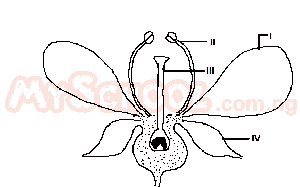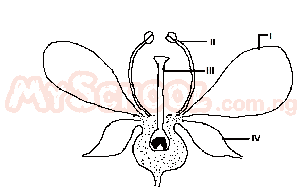Year :
1998
Title :
Biology
Exam :
JAMB Exam
Paper 1 | Objectives
21 - 30 of 50 Questions
| # | Question | Ans |
|---|---|---|
| 21. |
Which of the following is not a function of the mammalian skeleton? A. Protection B. respiration C. Transportation D. Support Detailed SolutionThe major functions of the skeletal system are body support, facilitation of movement, protection of internal organs, storage of minerals and fatWith the help of the lymphatic and circulatory systems, the skeletal system works with the respiratory system by creating red blood cells in the bones that aid in respiration facilitated by the lungs. |
|
| 22. |
 The ovary represented is A. half-superior B. inferior C. superior D. half-inferior |
B |
| 23. |
The most reliable estimate of growth is by measuring changes in A. length B. volume C. surface area D. dry weight |
D |
| 24. |
A dry fruit formed from two or more carpels containing several seeds is a A. follicle B. legume C. capsule D. schizocarp |
C |
| 25. |
The outermost embryonic membrane in the mammal is the A. amnion B. chorion C. allantois D. yolk sac |
B |
| 26. |
The small masses of nervous tissues in which many neurones have their nuclei are called A. dorsal roots B. ventral roots C. ganglia D. synapses |
C |
| 27. |
 The corolla is partly represented by A. I B. II C. III D. Iv |
A |
| 28. |
A group of organisms of different species living in a particular area is described as a A. colony B. community C. population D. niche |
B |
| 29. |
Which of the following is the direct consequence of transferring energy from one trophic level to another? A. An increase in biomass B. A decrease in the efficiency C. An increase in the total numbers of resulting individuals D. A decrease in the resulting biomass |
D |
| 30. |
The condition that encourages denitrification is A. low soil oxygen B. high soil nitrogen C. absence of soil bacteria D. lightening and thunderstrom |
A |
| 21. |
Which of the following is not a function of the mammalian skeleton? A. Protection B. respiration C. Transportation D. Support Detailed SolutionThe major functions of the skeletal system are body support, facilitation of movement, protection of internal organs, storage of minerals and fatWith the help of the lymphatic and circulatory systems, the skeletal system works with the respiratory system by creating red blood cells in the bones that aid in respiration facilitated by the lungs. |
|
| 22. |
 The ovary represented is A. half-superior B. inferior C. superior D. half-inferior |
B |
| 23. |
The most reliable estimate of growth is by measuring changes in A. length B. volume C. surface area D. dry weight |
D |
| 24. |
A dry fruit formed from two or more carpels containing several seeds is a A. follicle B. legume C. capsule D. schizocarp |
C |
| 25. |
The outermost embryonic membrane in the mammal is the A. amnion B. chorion C. allantois D. yolk sac |
B |
| 26. |
The small masses of nervous tissues in which many neurones have their nuclei are called A. dorsal roots B. ventral roots C. ganglia D. synapses |
C |
| 27. |
 The corolla is partly represented by A. I B. II C. III D. Iv |
A |
| 28. |
A group of organisms of different species living in a particular area is described as a A. colony B. community C. population D. niche |
B |
| 29. |
Which of the following is the direct consequence of transferring energy from one trophic level to another? A. An increase in biomass B. A decrease in the efficiency C. An increase in the total numbers of resulting individuals D. A decrease in the resulting biomass |
D |
| 30. |
The condition that encourages denitrification is A. low soil oxygen B. high soil nitrogen C. absence of soil bacteria D. lightening and thunderstrom |
A |